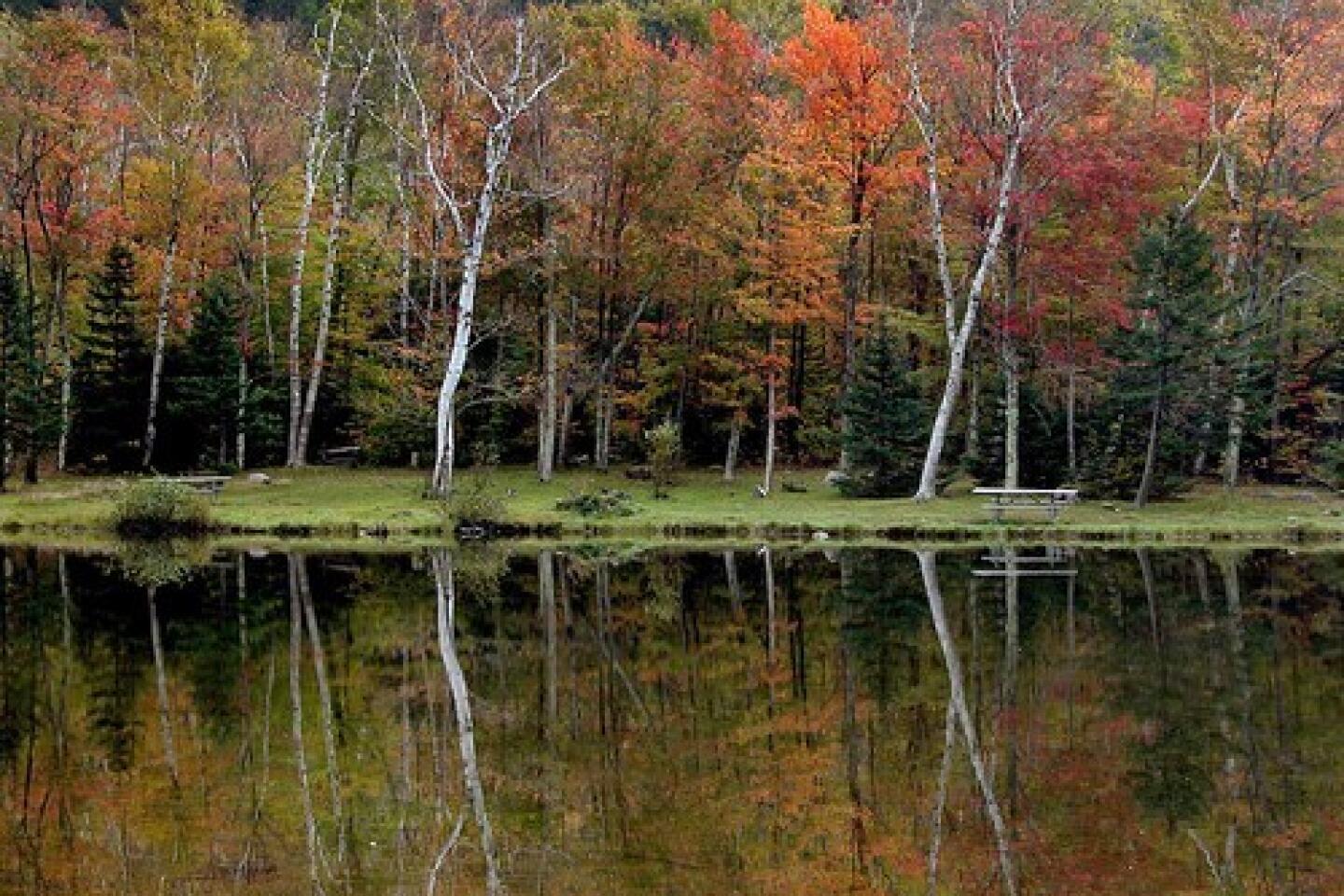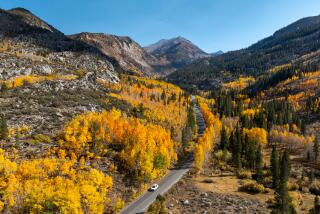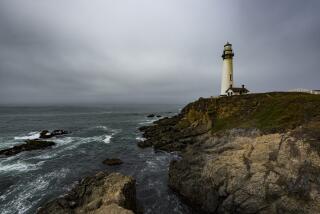New England: Cue the autumn hues
TWO pumpkins and a jolly scarecrow decorated the front porch of the house, a white clapboard Colonial in Farmington, Maine. A sugar maple tree in the frontyard had started to lose its leaves, and two boys were turning somersaults underneath it into a pile of scarlet and gold, a Dalmatian puppy yapping noisily as it tried to join in the fun.
A scene from a Norman Rockwell painting? No, a scene from a bus window as it rolled through town on a weeklong Trafalgar tour called Autumn Colors.
Several million people descend upon the rural back roads of New England every year in search of fall. They find it in small towns like Farmington, on shady trails through New York’s Adirondack and New Hampshire’s White mountains, along Maine’s rugged coastline and in farming communities in Vermont and New Hampshire. They find it in a reflection of brilliantly colored trees in a quiet pond, in the scent of apples in an orchard, in a momentary glance at boys rolling in a hill of leaves.
I had joined the Trafalgar group to sample one of the company’s tours, traveling anonymously as a consumer scout on an itinerary that covered 1,340 miles, from Boston to Maine, New Hampshire, Vermont, New York and back to Massachusetts. Trafalgar, which calls itself “the world’s favorite tour company,” is one of the world’s largest, moving about 90,000 travelers each year. Its rates are moderate — my trip cost $1,535 per person, double occupancy, including most meals (air fare was an extra $357) — and the company prides itself on offering first-class accommodations.
I planned to evaluate the trip, but I also wanted to take my first look at a New England fall. Would it — and the tour — meet expectations?
Disappearing whales
I could smell the ocean before I saw it. Salt and the tangy scent of seaweed drifted on the wind. We had left Boston around 8 a.m., driving north about 70 miles to York Beach, Maine. Clapboard houses and shops, a wide beach, a silvery sheet of sea glistening in the morning light. There were no trees in sight, but no one cared. The day was glorious.“We’re going to park, so everyone can get out and take a picture,” said tour guide Beverly LaFlamboy. “We’re going to stop and do this extra thing.”
I smiled. I’ve been on bus tours where there were no photo stops, regardless of the wow factor of the scenery.
The driver pulled the bus to the side of the road and many of the tour’s 51 participants clambered off, cameras at the ready. My fellow travelers hailed from North America and Australia; most were over 60 and from the Midwest.
“Ten minutes,” LaFlamboy shouted as we piled out, “or as long as it takes you to take a picture or two.”
We were back in the bus in a flash and off to our next stop, the Nubble Lighthouse at Cape Neddick Point, one of the most photographed on the East Coast. The sun was playing tag behind clouds, and we lingered on the cliffs overlooking the lighthouse, shooting pictures.
As LaFlamboy walked nearby, I stopped her to ask a few questions about our itinerary.
According to the Trafalgar brochure, the following day we would visit Acadia National Park, near Bar Harbor, Maine, and then have leisure time to take an optional whale-watching cruise. I wanted to make sure I didn’t miss the whales, I told her.
“Well, that doesn’t really work,” she answered. “We wish they’d change the brochure. There’s not enough time for that.”
My next question was about another stop we were to make later in the week, at the Naismith Memorial Basketball Hall of Fame in Springfield, Mass.
“That’s wrong too,” she said, shaking her head. “We get there after closing. But I’ll try to call ahead and ask for the gift shop to be open. People are really disappointed about that. But they can always take a picture of it from the outside.”
I tried not to look dismayed.
“What else is listed in the brochure that we don’t do?” I asked.
“I think those are the main two,” she answered.
When we were rumbling north on U.S. 1 again, LaFlamboy asked if we’d like to stop in Kennebunkport for lunch. Famous for its famous summer residents — former President Bush and his wife, Barbara — Kennebunkport drew a resounding yes from my bus-mates. The seaside town is a favorite of wealthy vacationers, with shops, restaurants, B&Bs and assorted mansions on hillsides overlooking the Atlantic.
“If the Bushes are home,” LaFlamboy told us, “the Texas flag and the U.S. flag will be flying over their compound. They’re often here this time of year. We run into Barbara in the pharmacy.”
I peeked in the pharmacy door as soon as we stopped in town but saw only greeting cards and medicines. We had better luck at the Bush compound. Both flags were flying high when we drove along Ocean Avenue past Walker’s Point, where the estate is clearly visible. My new friends raised a cheer.
We arrived late that afternoon in Bar Harbor — “Bah Habah,” Maine residents say — where we spent two nights at the Bar Harbor Regency, a Holiday Inn Sunspree Resort. The hotel’s rooms are plain but spacious and the facility is beautifully sited, overlooking Frenchman’s Bay. Our rooms were at the back of the hotel, overlooking a parking lot, a common occurrence on this tour. A Trafalgar representative said it was “by chance” that our rooms were less desirable.
Bar Harbor is another popular Maine tourist town, and we enjoyed its shops and restaurants after a half-day tour of nearby Acadia National Park. The park, the first one established east of the Mississippi River, is a showplace for Maine’s rugged coastline and fragrant spruce forests. I could have spent a week exploring its meandering hiking trails and bike paths. It was a trip high point.
All in the timing
TWO types of fall-color enthusiasts arrive in New England annually.“Leaf peepers and leaf peakers,” naturalist Chris Lewey told our Trafalgar group during a presentation at our hotel in North Conway, in New Hampshire’s White Mountains.
Leaf peepers are easy to please, he said. Give them a hillside of sugar maples evolving from green to yellow to orange and red, and they’re delighted. Peakers are another story.
“Peepers are fine, but we get a lot of calls this time of year from the peakers,” said Lewey, who founded Raven, a New England environmental group. “They say: ‘Will the peak be on Thursday? I’m planning to come Thursday. About 10:45. Does that sound right?’
“Sorry,” he said, laughing. “No one can predict that.”
Timing is an important element of a fall-color trip. Arrive too early and leaves still will be green; arrive too late and trees will be bare. If a sudden storm hits, all bets are off.
The seasonal beauty makes it a popular destination. Some of our stops were spoiled by hordes of other buses: We jockeyed with tourists from five buses during a snack stop in Bath, N.H., a tiny town with a covered bridge and the Brick Store, which advertises itself as America’s oldest general store.
But traveling in a car has downsides too. A couple on the Trafalgar tour said they had tried driving a similar route last year and found they had to stop each day by 1 p.m. or they would be unable to find a place to stay.
Leaf peakers would say the Trafalgar tour I took was a bit early: It began on Sept. 24, one day after the autumnal equinox — the official start of fall. (Similar Trafalgar tours are scheduled through this week.) But I was happy with the result.
As our bus wended its way through New England, I saw areas where most trees were still green, and areas where the mountains were alive with intense color. It was a wonderful sampling of New England’s best and brightest.
And Lewey’s presentation, both funny and educational, helped bring some perspective to the journey. It was a welcome feature of the tour.
Other things didn’t work as well. Our bus driver made so many U-turns — he apparently was unsure of the route — that people started making bets on when the next one might be.
There were other transportation problems too. To the uninitiated, a seat on a bus seems an unimportant thing; to those on a weeklong bus tour, it is everything. A seat in the back is to be avoided at all costs: Visibility is bad and you’re always last to exit — meaning last in line for lunch, snacks or bathroom breaks.
LaFlamboy had told our group that we should change seats daily, moving forward or backward three rows in a clockwise direction. Many people weren’t sure how to do this and stayed put. Some of those trapped in the back staged a minor uprising, demanding to be moved nearer the front.
“This is not right, and I can’t stay quiet any longer,” said an Australian woman. “Some of these people are older; they can’t figure out where you want them to sit.”
LaFlamboy replied that “I treat people like adults, not children.” But she quickly complied with requests and made sure everyone moved according to her plan.
One of the best things about the trip were the daily special attractions. We soared in a gondola over Wildcat Mountain, a ski area in the White Mountains ; gaped at the mansions — the upper crust refer to them as camps — that line lovely Lake Placid in New York’s Adirondack Mountains; and traced Paul Revere’s famous midnight ride to Lexington, Mass.
Some stops were timed well; others were not. We had only about an hour to see Concord and Lexington, for instance, and people complained.
LaFlamboy agreed: “We wish they wouldn’t include this on the itinerary; we need the better part of a day. But at least you get a glimpse of it.”
Australian Daisy Tan called it “hop, skip and jump travel. You have to hop out of the bus, skip to take a quick picture, then jump back on the bus in a hurry.”
Tan also said she wondered about the location of some of the places we stayed. In Springfield, for example, we were in an interstate-adjacent motel, bounded by a truck stop and railroad tracks.
“Why didn’t we stay in one of these charming little towns we’ve driven through?” she asked.
But other accommodations were fine. The highlight was the Hilton Lake Placid Resort, where all rooms face picturesque Mirror Lake. An excellent dinner was included in the tour price.
I asked Mary-Anne Dietz, vice president of sales for Trafalgar, about the accommodations — the tour company advertises them as being first-class.
“They’re first-class whenever possible,” she said. “In some out-of-the-way areas, it depends on what is available; we always try to get the best options, but sometimes our choices are limited.”
Clarence Guebert of Redbud, Ill., who celebrated his 76th birthday during the trip, thought it was money well spent.
“For the price, it’s a good value,” he said, “considering the hotels and the food you get. I’d recommend it.”
My only wish? That I’d had a little more time to turn somersaults in a pile of autumn leaves.
*
(INFOBOX BELOW)
Rating the tour
The company
Name: Trafalgar Tours, part of the Travel Corp., based in London. Other Travel Corp. companies include Contiki Holidays and Insight Vacations.
Target audience: Travelers older than 45 seeking escorted tours
Type of tours: 200 itineraries worldwide, moving 90,000 travelers per year
Accommodations: The company advertises them as first-class.
For more information on Trafalgar Tours: (866) 544-4434, https://www.trafalgartours.com
For more information on fall color in New England: https://www.yankeefoliage.com , https://www.foliage-vermont.comwww.mainefoliage.com
foliage.visitnh.gov
https://www.iloveny.com <252>*
The tour
Trafalgar Autumn Colors
(On a scale of one to five stars)
Itinerary: ***
Guide & Driver: **
Lodging: **
Food: **
Value: ***
Overall experience: ** 1/2
Would I recommend this tour? Maybe. It’s a good value for people who dislike trip planning and would like a guide, driver and someone to transport luggage.
Price: $1,535 per person, double occupancy (land only for seven nights; includes most meals)
Per-night charge: $219 (per person, based on double occupancy)
Charge per night if booked separately: $163 (land only, based on double occupancy and including car rental and gas)
*
Pros:
Variety of scenery (coastal, mountain, small town, city)
Spectacular season to tour region
Special attractions, events scheduled daily
Includes photo stops; optional tours are appropriate.
Cons:
Most accommodations are not first class. Meals ranged from excellent to mediocre.
Some stops on itinerary are ill-planned, with inadequate time to view attractions.
Some overnight stops defy logic. Why spend the night in a freeway-adjacent motel in a region known for its beautiful inns?
Tour managers (driver and guide) seemed inexperienced with route and some details of the trip.
— Rosemary McClure
More to Read
Sign up for The Wild
We’ll help you find the best places to hike, bike and run, as well as the perfect silent spots for meditation and yoga.
You may occasionally receive promotional content from the Los Angeles Times.















